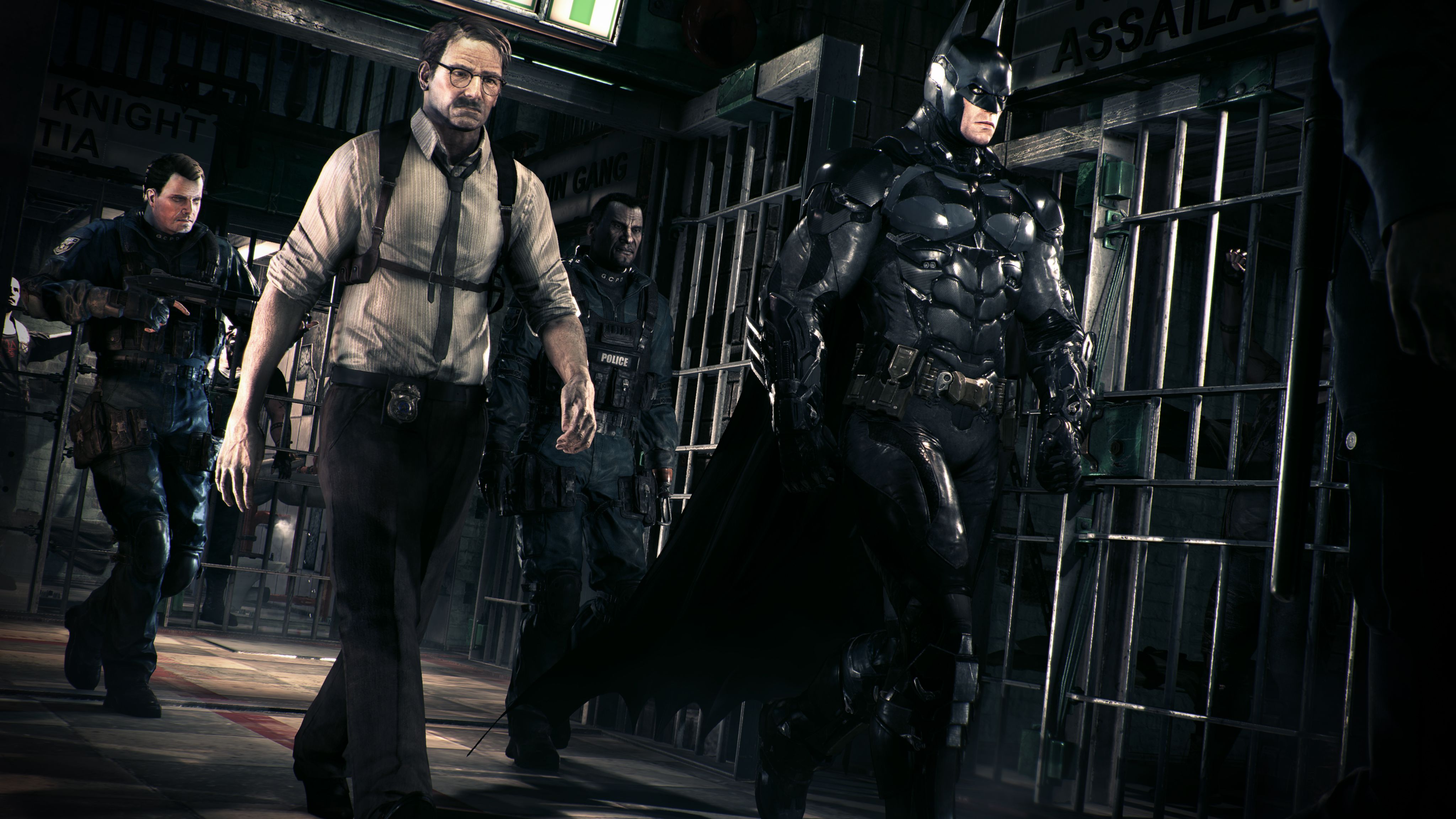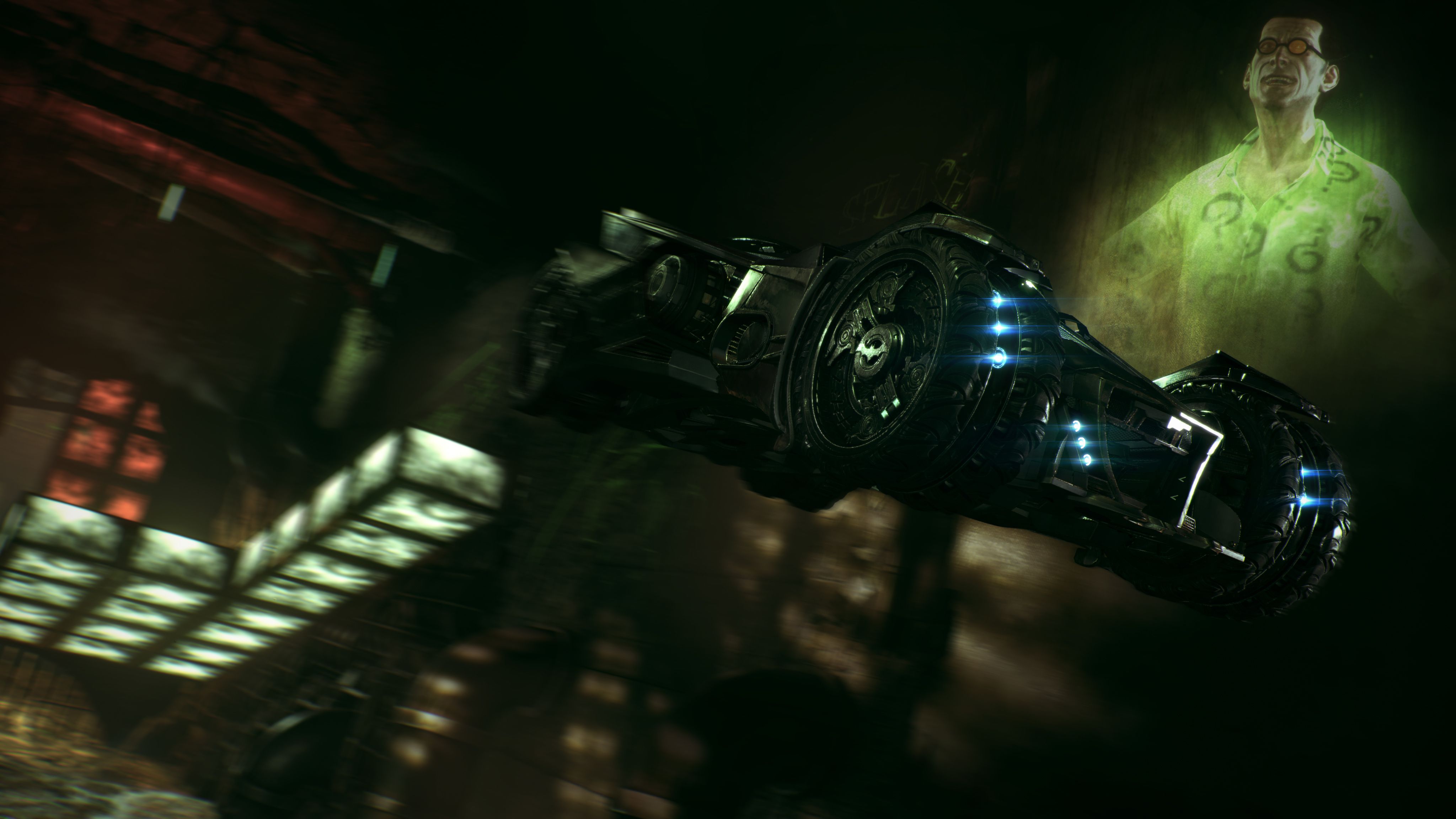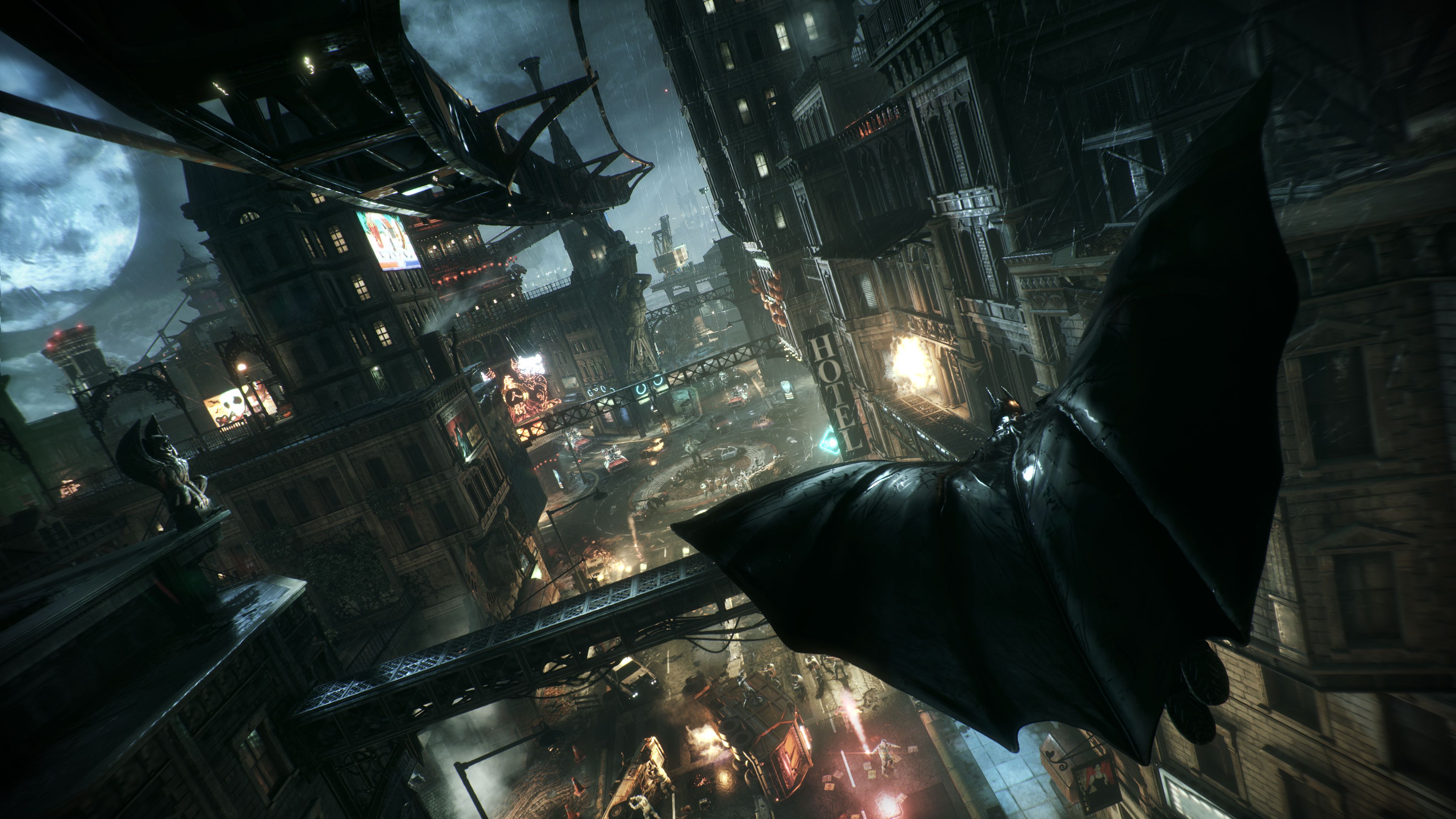Batman: Arkham Asylum is one of my favorite video games. Following Batman: The Animated Series, it’s probably the best Batman adaptation (perhaps not coincidentally, Paul Dini wrote both). The Metroid-style gameplay worked wonderfully with the atmospheric traversal through the dark corridors of Arkham Aslyum, and most importantly, you felt like you were Batman. Unlike other stealth games where hiding feels like cowering, in Arkham Asylum, you always felt like you were in control. The darkness was your weapon, the bad guys were at your mercy, and I received no shortage of joy from having my mere presence instill heart attacks in the cowardly lot.
“Be the Batman” may be the tagline for the trilogy’s conclusion, Batman: Arkham Knight, but the series has veered away dramatically from what made Asylum and Arkham City work. Rocksteady glommed on to making the Batmobile a key part of the gameplay, and it’s a part that ruins just about everything. What’s left standing are repetitive, unimaginative side quests, a drab Gotham City, and a rotten story that’s slightly remedied by an ingenious twist, but isn’t enough to stop the game from feeling like one long, tedious night.
The Setup
The good people of Gotham are out enjoying their day when Scarecrow (John Noble) unleashes a sample of his fear toxin inside a restaurant, which causes the patrons to tear each other apart (this is the third time this year I’ve seen this plot device used). Scarecrow sends out a message to Gotham that he’ll unleash the toxin soon, but will give people a chance to evacuate. It’s for an asinine reason that leaves Gotham completely in the hands of the city’s criminals and a milita force led by the mysterious Arkham Knight (Troy Baker), who has a personal vendetta against Batman (Kevin Conroy). Naturally, it falls to Bats to stop the Scarecrow and the Arkham Knight and reclaim Gotham.
Tanking It
To reclaim Gotham, Batman uses a tank. The Batmobile is outfitted with a cannon, chain gun, and can ram through just about everything, which can be incredibly frustrating when you’re not sure if you can drive through a pillar or if it’s immovable (always a fun discovery when you’re in the middle of a chase or trying to flee from your enemies). The game has to make silly concessions for how you’re not going to kill bystanders, so when your car hits a pedestrian criminal, he’ll get electrocuted out of the way. Your cannon will also shoot non-lethal rounds at individuals. It’s only explosive when firing at drone-operated tanks or breakable walls.
The game never adequately explains why the Arkham Knight, who knows that Batman’s code prevents him from killing, would send in unmanned drones. But lazy reasoning is par for the course, and while games should have a little leeway in tweaking the story to allow for the most fun experience possible, the unmanned drones is in service of atrocious gameplay that saps any joy from the proceedings and eliminates the feeling that you’re Batman.
Any simple task is rendered more difficult and less rewarding by incorporating the Batmobile. Early in the game, you need to reroute some power, and Rocksteady thought this would be a good time to show you how the Batmobile can jump over a gap, traverse rooftops, and then use its winch to send energy to a power source. This simple act took me at least ten minutes as the Batmobile fell off the roof more than once, and I guess I should be grateful that this is the only time in the game where you have to put the Batmobile on rooftops.
But I’d be truly grateful if playing the Batmobile was fun. Set aside that using a tank deeply devalues the thrills of playing as Batman. The Batmobile controls are ridiculously shitty. There’s a Driving Mode and a Battle Mode, and you have to hold down a button to stay in Battle Mode, which remaps the other buttons to different functions. Additionally, the default button mapping puts brake/reverse on a face button rather than a shoulder button, which is counter intuitive. I found out far too late that you could toggle to a different button layout by going to options (toggling “Battle Mode” doesn’t tell you what the new buttons will be, so the toggle doesn’t give you any indication what turning it on or off will do for your controller).
My experience driving the Batmobile ranged from tolerating it to outright loathing it. Rocksteady completely lost sense of what made the previous two games work and fell in love with tank combat that has you strafing around cannon fire and trying to sneak up on drones that can kill you in a few shots. For the latter, I understand the studio’s thinking of trying to meld the stealth aspect with tank battles, but that doesn’t change the ridiculousness of trying to be stealthy with a tank. Additionally, what made the stealth aspect work in previous games was variety. You could go after your enemies in a variety of ways. In a tank, you just try to slowly get around another tank until you can shoot it in the back.
Then there’s trying to drive the damn thing, which is another pointless chore. It’s not fun to drive the Batmobile. There’s no thrill from it, and at worst it echoes Christopher Nolan’s Dark Knight Trilogy where Batman has total disregard for anyone’s property (Arkham Knight notches a point for the city at least being uninhabited by fine, upstanding citizens who won’t be near their car when Batman drives over it). But more than anything: why drive when you can fly? Gliding returns (although for some reason the game delays giving you back your full flying powers until you get a new suit early on from Lucius), and it will get you across large distances much faster and much easier than driving. And it’s not like there’s a lot you’ll want to see on the ground level because Gotham City is an unimaginative dump.
Dark City
In Arkham City, various criminals owned different pockets of the city, and so it felt like there was diversity. Like Arkham Asylum, new places actually felt new and different than what had come before, and they contributed to creating a rich, unique setting. In Arkham Knight, Gotham City is like a giant heap of coal slag with neon lights. Otisburg isn’t significantly different than Dresden or anywhere else on the map. There’s certainly no desire to explore just to admire because once you’ve seen part of Rocksteady’s Gotham City, you’ve pretty much seen it all.
Rocksteady may have been vaguely aware of just how uninteresting their Gotham is since sidequests require you to just fly or drive around aimlessly until an objective pops up. Sometimes the game will be charitable and give you intel on where to go, but more often than not, you’ll just be flying around and you’ll be notified that there’s a fireman you have to save or a new clue to investigate. Side missions, by their very nature, lack urgency, but in Arkham Knight, their inclusion feels sloppy. You can’t give these side missions priority because they’re almost random. Perhaps the developers thought you would be so grateful to cruise around an ugly Gotham in your crummy Batmobile that you wouldn’t mind searching for the last militia base rather than actually destroying it and moving on to the next repetitive task.
Repeat Offenders
There are really only a handful of side missions in Arkham Knight, but the game inflates its content by making you do the same kind of side mission again and again with only minor variations. You’ll need to take out watchtowers, and sometimes you’ll do it through stealth and other times it will be against a large group of thugs, but it will be either one or the other. You’ll also need to disarm roadside bombs, which involves fending off drones while you upload a virus. The number and kind of drones may vary, but it’s the same setup, which makes it a chore.
I like side missions, but Arkham Knight reeks of padding, and while one could argue that there’s nothing wrong with the game trying to incorporate its three main kinds of gameplay—tank battles, stealth fighting, and group brawls—into different scenarios, the arbitrary nature of the game becomes overwhelming. Rather than making the series feel bigger, Arkham Knight takes the excellent concepts of the original game and stretches them to their breaking point. There are a few nice touches like some new gadgets or the addition of medics who can heal the guards you’ve taken out, but eventually it starts to feel like the developers ran out of ideas and the different scenarios are just window dressing.
[The next section contains spoilers, so skip past it if you haven’t finished the game.]
The Awful Story [SPOILERS]
After fumbling through an explanation of why the Scarecrow allowed Gotham to be evacuated before unleashing his fear toxin, the game’s first serious misstep comes with kidnapping Oracle. A strong supporting character is reduced to a damsel in distress, and her role in Batman’s operation is completely undermined since it seems that Alfred can do her job just as well as she can.
Then the story gets the worst of both worlds by pretending to fridge her. It plays into the tired trope of “Dead woman serves as male hero’s motivation” and then it doesn’t have the courage of its convictions to make Oracle stay dead. I wasn’t relieved Oracle was alive; I was ticked off that she’d been used so poorly and that I couldn’t have a strong supporting character for the majority of the game (no offense, Alfred).
As for the Arkham Knight, even before the lame Jason Todd reveal, he’s an irritating character. He may wear a mask, but he’s not mysterious because he doesn’t ever shut up. He sounds like a common street punk who wants to take Batman’s lunch money. He’s whiny, non-threatening, and constantly annoying. And like Scarecrow, he just won’t shut up. At least with Joker, the constant talking is part of the character’s shtick, and it worked well in Arkham Asylum. In Knight, it feels like the developers trying to use characters that can’t possibly fill Joker’s shoes, and at one point I’m pretty sure I screamed at the TV, “Oh, for fuck’s sake—SHUT UP, DENETHOR.”
Then there are the three endings with each one worse than the one before. Arkham Knight doesn’t have a complete narrative. It’s not like Chrono Trigger where you beat the game, and then there are different endings that feel like bonuses that still feel organic to the overall narrative since the story involves time travel changing history. Arkham Knight is like a tired parent who is bargaining with a child to do more chores and that there will be some reward when all the tasks are complete. And when you finally reach 100%, you get an ending that makes no goddamn sense. It’s not even ambiguous. Ambiguousness implies thoughtfulness. This is a churlish shrug of an ending that signifies nothing.
[END SPOILERS]
The Lost Knight
Batman: Arkham Knight falls victim to what afflicts most major blockbuster franchises—quantity over quality. There’s technically “more” to do in Arkham Knight with an open world and a tank, but it loses what makes the franchise special, which is that you felt like Batman. Instead of feeling like the Dark Knight, Arkham Knight only conjures up bitterness, remorse, and anger. You’re all of Batman’s weaknesses, and none of his strengths, no matter how many people you bulldoze while driving through Gotham.
Rating: D-







